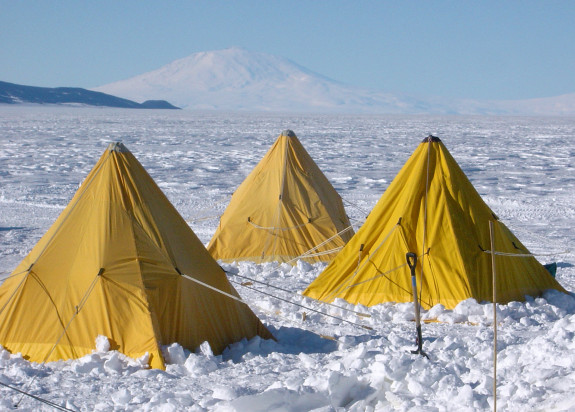GNS Science’s Antarctic summer is underway

GNS Science is starting a super season in Antarctica this summer! Check out some of the cool work our experts are doing.
GNS Science experts Katelyn Johnson and Regine Morgenstern are joining a team that are hot water drilling at the Kamb Ice Stream in a difficult-to-access area of the Ross Ice Shelf. They are melting a hole through the ice shelf to access the cavity below, then collecting sediment samples.

Once drilled, scientists will deploy other instruments into the hole to take measurements that will help us better understand ice and ocean dynamics within the cavity. This is a rare and untapped region the size of France – any observation we make is hugely beneficial to our overall understanding of ice melt and sea level rise.
The team are also collecting snow samples on the Ross Ice Shelf to analyse back at our ice core facility in Wellington. This a fabulous continuation of our collaborations with the Antarctic Science Platform, Te Herenga Waka—Victoria University of Wellington, and NIWA, with the enduring support of Antarctica New Zealand.
The past is the key to our future | Dr. Katelyn Johnson – Dr. Katelyn Johnson on time capsules frozen in Antarctic ice transcript
Paleoclimate science is vitally important to our understanding of the whole climate system, because the past is the key to our future.
I'm Katelyn Johnson, I'm a Paleoclimate scientist at GNS science. What that means is I study how climate has changed in the past. In order to do this I utilize a record called an ice core.
Me and my team travel all the way down to Antarctica and spend several months down there drilling these long cylinders of ice from the ice sheet.
This ice forms as snow falls from year to year and that forms layers in the ice, and if you can imagine this long cylinder of ice is kind of like a book where each layer is a different page.
Each page contains vast amount of information about the climate but one of the most important ones are the little tiny air bubbles that are trapped that form tiny time capsules capturing the atmosphere at a given time.
When we talk about changing greenhouse gas concentrations the way we are able to understand that our current greenhouse gas concentrations are so much higher than they've ever been, is by analyzing these tiny bubbles.
Paleoclimate records are important for a variety of reasons we need as much information we can about the past in order to understand how the climate has changed naturally without human influence. That involves taking paleoclimate records such as corals, stalactites, stalagmites sediment cores, ice core records from all over the world.
If you can imagine we really only have observational records since about the 1850s, and we only have satellite records from about the 1970s. So if we want to understand how climate has changed over hundreds of thousands to millions of years, these paleoclimate records are vitally important.
Paleoclimate scientists will continue to go all over the world to these remote locations gathering these records in order to help us understand the challenges we're facing.
The past is the key to our future | Dr. Katelyn Johnson
Doubling up on our geomagnetic observatories ahead of the new Scott Base
Our old Antarctic geomagnetic observatory has been running faithfully at Scott Base since the late 1950s. With the exciting news of a Scott Base rebuild, we need to make some changes to the observatory to ensure accurate geomagnetic measurements. It’s an important site for global geomagnetic measurements, as it’s one of only a very few observatories with close proximity to the South Pole.
Geomagnetic observatories need to be in quiet magnetic settings away from lots of steel and magnetic rocks. Our field operations technician, Merijn Thornton, is heading down to set up a new observatory five kilometres away from Scott Base at Arrival Heights – a magnetically quiet location. This will allow more than a year’s overlap of data with the old observatory before we decommission it once the new Scott Base is built.

Investigating greenhouse gas emissions from the Antarctic permafrost
Our Chief Scientist, Gary Wilson, is building on initial survey work and earlier measurements that suggest greenhouse gas emissions from frozen ground in the Antarctic Dry Valleys have doubled over the last five years. He and his collaborators from the Italian National Institute of Geophysics and Volcanology are now working to find the origin of these gases.
The team thinks that the gas emissions may be coming from brines flowing from under the East Antarctic Ice Sheet. They will test this theory this summer with resistivity surveys to map the structure of the frozen ground, increasing our understanding of the impact that further emissions will have on global warming and Antarctic ice.
Using sound to see deep beneath the ice
Jenny Black, a data technician in our geospatial and data analysis team, and PhD student Matt Tankersley are joining a group conducting an over-ice seismic survey.
Using weak explosives to create a noise in the Ross Ice Shelf, they will use geophones – microphones on the surface – to measure the sound reflection off the rocks and seafloor below.
This will tell us what the bathymetry is like below the ice shelf and will help inform future research projects, like where to drill for different research purposes.

Volcano monitoring and hazard and risk assessments
Volcanic geologist and hazard and risk specialist, Graham Leonard, is spending a month in Antarctica, setting out geophysical arrays in the Dry Valleys.
He will also make a reconnaissance flight around Erebus to scope out potential volcano monitoring sites, inspect existing monitoring sites that have ceased transmitting data, and capture some high-resolution imagery to conduct further hazard assessments of the crater area.
